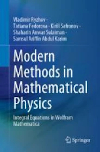- About MAA
- Membership
- MAA Publications
- Periodicals
- Blogs
- MAA Book Series
- MAA Press (an imprint of the AMS)
- MAA Notes
- MAA Reviews
- Mathematical Communication
- Information for Libraries
- Author Resources
- Advertise with MAA
- Meetings
- Competitions
- Programs
- Communities
- MAA Sections
- SIGMAA
- MAA Connect
- Students
- MAA Awards
- Awards Booklets
- Writing Awards
- Teaching Awards
- Service Awards
- Research Awards
- Lecture Awards
- Putnam Competition Individual and Team Winners
- D. E. Shaw Group AMC 8 Awards & Certificates
- Maryam Mirzakhani AMC 10 A Awards & Certificates
- Two Sigma AMC 10 B Awards & Certificates
- Jane Street AMC 12 A Awards & Certificates
- Akamai AMC 12 B Awards & Certificates
- High School Teachers
- News
You are here
Modern Methods in Mathematical Physics: Integral Equations in Wolfram Mathematica

Publisher:
Springer
Publication Date:
2022
Number of Pages:
204
Format:
Paperback
Price:
49.99
ISBN:
978-9811949142
Category:
Textbook
[Reviewed by , on ]
John D. Cook
06/17/2023
Linear integral equations typically fall into one of four broad categories: Fredholm and Volterra equations of the first and second kinds. In Fredholm equations, the integral is over a fixed interval, while in Volterra equations the upper limit of integration is variable. In equations of the first kind, the unknown function \( \varphi \) appears only inside the integral. In equations of the second kind, the unknown function ' appears both inside and outside the integral. The equations below summarize the four categories in their one-
dimensional forms. All may be generalized in a straightforward manner to more dimensions.
- Fredholm I: \( \varphi(x) - \int_{a}^{b} K(x,y) \varphi(y) dy = f(x) \)
- Volterra I: \( \varphi(x) - \int_{a}^{x} K(x,y) \varphi(y) dy = f(x) \)
- Fredholm II: \( \varphi(x)-\lambda \int_{a}^{b} K(x,y) \varphi(y) dy = f(x) \)
- Volterra II: \( \varphi(x) - \lambda \int_{a}^{x} K(x,y) \varphi(y) dy = f(x) \)
The main title of the book Modern Methods in Mathematical Physics is not very informative. The specific content of the book is relegated to the subtitle: Integral Equations in Wolfram Mathematica. The book is devoted to the four types of integral equations shown above, usually but not always in one dimension. The book contains a brief section on integro-differential equations, and a couple of examples of nonlinear integral equations, but the large majority of the book concerns linear integral equations. Modern Methods contains examples of integral equations that arise in physics but the reader need not have a background in physics.
The emphasis of the book is on finding closed-form solutions to integral equations, though it has a chapter on approximate solutions. Solutions to example problems are computed, or at least verified, using Mathematica. The book assumes the reader is familiar with Mathematica and doesn't give much instruction on using Mathematica per se at the level of syntax. It does, however, have a few things to say about the use of Mathematica at a problem-solving level, such as how to re-formulate a problem when Mathematica is unable to solve the most direct formulation of a problem. In addition to the general forms of the integral equations listed above,
Modern Methods looks at special cases that have computational and theoretical advantages, namely difference kernels and symmetric kernels. Kernels refer to the function \( K \) above. We say \( K(x, y) \) is a difference kernel if \( K \) depends on \( x \) and \( y \) only through their difference \( x-y \). We say that \( K \) is symmetric if \( K(x, y) = K(y, x) \).
Modern Methods presents a variety of solutions techniques, such as turning special kinds of integral equations into differential equations, or using Laplace and Fourier transforms. The chapter on approximate methods covers well-known techniques such as successive approximation and Galerkin's method. The methods in Modern Methods are not particularly modern, dating back a century, though of course, the use of Mathematica is more modern. The use of Mathematica is a major strength of the book. The authors present many examples, and give the reader the tools to pursue more examples, making its subject more tangible. The book concludes with 50 exercises and includes answers but not detailed solutions.
John D. Cook is a consultant working in applied mathematics.
See the publisher's website.
- Log in to post comments




